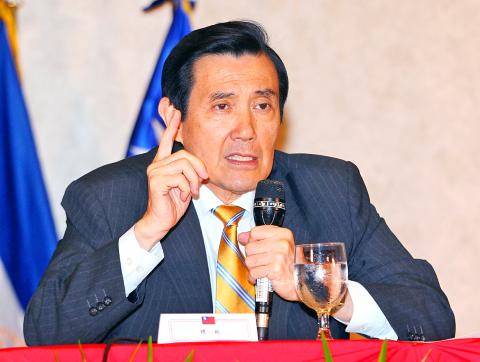President Ma Ying-jeou (馬英九) yesterday emphasized the importance of “peaceful resolution” of a conflict when he commented on the recent landmark change in Japanese Prime Minister Shinzo Abe’s security policy that ends Japan’s long-standing ban on exercising collective self-defense.
In contrast to the immediate support the US has expressed for the decision, the Ma administration has responded to the issue with caution, saying that the government is “closely watching” Japan’s new defense policy.
Given the tense situation in the East China Sea due to territorial rows, it is everyone’s concern that Japan and China could go to war, and if that happens it would certainly implicate the US, Ma said when asked to comment on the issue at a press conference in El Salvador, which was broadcast live from the Presidential Office.

Photo: CNA
Saying that Japan’s new defense policy has drawn disagreement among people in Japan, Ma highlighted the importance of the “principle of peaceful settlement of international disputes” — as stipulated in the UN charter.
“If the principle is not upheld, some dreadful events could be inevitable,” Ma said.
Ma was asked what impact US support for Japan’s new defense policy would bring to cross-strait relations.
The Taiwan Strait is a far more serious flashpoint than the East China Sea, but the US can now rest assured as cross-strait rapprochement continues, Ma said.
The US would surely get involved in the event of a cross-strait conflict, but it would be a very hard problem to resolve even if the US is part of the situation, Ma said.
Ma said he did not characterize the US’ policy of rebalancing toward Asia as a new strategy to contain China, as many people have likened it to the US’ containment policy toward China laid out by former US ambassador to the Soviet Union George Kennan in the 1950s.
The situation today differs from what it was in the 1950s in two respects: first, Asian countries engage with China economically, while relying on the US for security; second, with China rising and Japan having a mind of its own, the US does not have strong advantages in the region as it had back then, Ma said.
Given the situation, Taiwan can play a positive role as it has been doing by pursuing a cross-strait structure of permanent peace, he said.
The agreement Taiwan signed with Japan last year to end controversies over fishing in waters surrounding the disputed Diaoyutai Islands (釣魚台) was a testimony of how the nation has played peacemaker, Ma added.
Meanwhile, Ma reiterated his long-stated wish to meet with Chinese President Xi Jinping (習近平), with a focus on creating a path for both sides to maintain permanent peace and prosperity.
In the normal course of events, the significant changes in cross-strait relations over the years would entail “a meeting between leaders on both sides of the Taiwan Strait,” he said.
Ma said that the suggestion offered by China’s Association for Relations Across the Taiwan Straits Vice Chairman Sun Yafu (孫亞夫) that Taiwan invite Xi for a visit was never brought up for discussion in cross-strait talks.
He said he views an APEC forum as the best venue for a meeting.

The US government has signed defense cooperation agreements with Japan and the Philippines to boost the deterrence capabilities of countries in the first island chain, a report by the National Security Bureau (NSB) showed. The main countries on the first island chain include the two nations and Taiwan. The bureau is to present the report at a meeting of the legislature’s Foreign Affairs and National Defense Committee tomorrow. The US military has deployed Typhon missile systems to Japan’s Yamaguchi Prefecture and Zambales province in the Philippines during their joint military exercises. It has also installed NMESIS anti-ship systems in Japan’s Okinawa

‘WIN-WIN’: The Philippines, and central and eastern European countries are important potential drone cooperation partners, Minister of Foreign Affairs Lin Chia-lung said Minister of Foreign Affairs Lin Chia-lung (林佳龍) in an interview published yesterday confirmed that there are joint ventures between Taiwan and Poland in the drone industry. Lin made the remark in an exclusive interview with the Chinese-language Liberty Times (the Taipei Times’ sister paper). The government-backed Taiwan Excellence Drone International Business Opportunities Alliance and the Polish Chamber of Unmanned Systems on Wednesday last week signed a memorandum of understanding in Poland to develop a “non-China” supply chain for drones and work together on key technologies. Asked if Taiwan prioritized Poland among central and eastern European countries in drone collaboration, Lin

BACK TO WORK? Prosecutors said they are considering filing an appeal, while the Hsinchu City Government said it has applied for Ann Kao’s reinstatement as mayor The High Court yesterday found suspended Hsinchu mayor Ann Kao (高虹安) not guilty of embezzling assistant fees, reducing her sentence to six months in prison commutable to a fine from seven years and four months. The verdict acquitted Kao of the corruption charge, but found her guilty of causing a public official to commit document forgery. The High Prosecutors’ Office said it is reviewing the ruling and considering whether to file an appeal. The Taipei District Court in July last year sentenced Kao to seven years and four months in prison, along with a four-year deprivation of civil rights, for contravening the Anti-Corruption

NO CONFIDENCE MOTION? The premier said that being toppled by the legislature for defending the Constitution would be a democratic badge of honor for him Premier Cho Jung-tai (卓榮泰) yesterday announced that the Cabinet would not countersign the amendments to the local revenue-sharing law passed by the Legislative Yuan last month. Cho said the decision not to countersign the amendments to the Act Governing the Allocation of Government Revenues and Expenditures (財政收支劃分法) was made in accordance with the Constitution. “The decision aims to safeguard our Constitution,” he said. The Constitution stipulates the president shall, in accordance with law, promulgate laws and issue mandates with the countersignature of the head of the Executive Yuan, or with the countersignatures of both the head of the Executive Yuan and ministers or